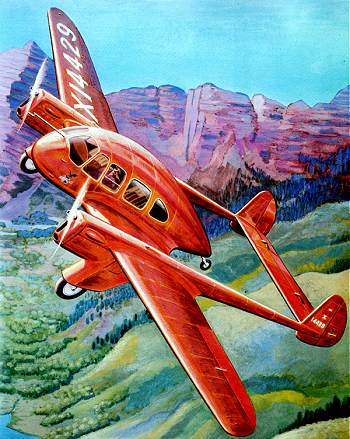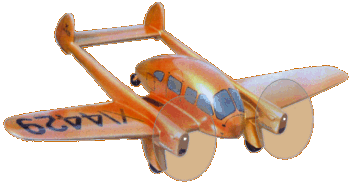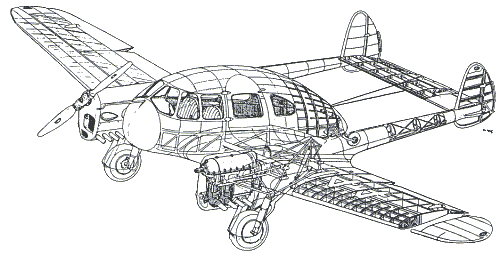|
Design Patent Flap Nothing New By Carl Caiati Book review of: At first blush, "design patent" might seem a curious oxymoron. Logos and art are often protected by copyright and/or trademark. But can related concepts as fluid and adaptable as visual designs be patented as well? It's a question embroiling artisans on the resort island of Nantucket, Mass. Who owns the design of a lightship basket-cum-handbag with a kidney-profile cross section? (Cf. The Wall Street Journal and Boston Globe, Oct. 7, 1991.) Instead of a new and litigious low however, that bouleversement may reflect an intriguing, thorny debate with long history and wide application. When is an ornament, appearance or shape sufficiently distinctive to merit the protection of a patent? And how valid are design patents for its enforcement?
The controversy centered on one young, Colorado-born and relatively lone aerodynamicist. Thomas Shelton was an genius engineer by all accounts -- not the least of which is author Alexander Roca's beautiful and exhaustive book, masterfully illustrated in the best coffee-table tradition. He designed, somehow (in the capital-scarce Great Depression) obtained funding for, and built in Denver, a spectacular twin-engined prototype aircraft. Christened the Crusader, it was a significant advance in aerodynamic efficiency. Even with relatively small engines, it performed on par with the then-first-line fighter of the U. S. Army Air Corps, the Boeing P-26A. Like many other airplanes of the day, that stubby, pugnacious pursuit ship bullied its way through the air via a monster motor of a thousand-plus cubic inches. In contrast, Shelton's craft gently parted the atmosphere via sophisticated “melted-bean” streamlining that would nave been the envy of today's supercomputer-equipped automotive design studios. It was an early, truly modern effort of the kind that would ultimately contribute to Allied air superiority in World War 11 and a domestic aircraft industry still pre-eminent today.
Shelton's ship soon hopscotched America, attracting widespread critical acclaim and business interest. Its fans ranged from Denver housewives to aviation's nobility. None other than Howard Hughes, in perfect form, offered to buy it outright. And Amelia Earhart paid it a visit to lend enthusiastic endorsement. With typical care, the book documents the latter with news clippings and several never-before-published photos of the famed aviatrix. "Crusader" goes on to sample a culture increasingly fascinated with Art Deco twin-boom and teardrop designs. There appear magazine covers, advertisements, fiction illustrations, metal toys, dream cars and dozens upon dozens of other twin-boomed airplanes. Roca illuminates the craze further with specially-commissioned drawings from accomplished artists Burt Mader, Sheridan Barnard and John Two McClure. (McClure got to sit in the Crusader cockpit as a boy; so vivid was the memory that, five decades later, he drew the craft largely from recollection in his Columbus, New Mexico, studio.) Reportedly even Howard Hughes dryly acknowledged the appeal of things twinboomed. Industrialist Henry Kaiser once asked if HH's reluctance to enter a venture grew from involvement with another, in the parlance of the day, "twin-boom job". Hughes was then directing The Outlaw motion picture and engineering a push-up bra for buxom actress Jane Russell. So in response he cracked the barest of smiles and nodded knowingly, But what of young Shelton at the eye of this whirlwind? He had obtained a design patent for his distinctive Crusader. Secure that it protected his idea, he proceeded to enlist facilities for volume production. That meant disclosing details to aircraft builders and potential adversaries. Roca's fascinating story of how that business effort started so spectacularly could ultimately founder unfolds in gripping detail. It touches on the murky underbelly of pioneering aviation: company-internal skullduggery, bureaucratic intransigence, plain bad luck and perhaps a whiff of government/industry collusion.
Some of foregoing technicalities may interest only patent attorneys, aviation scholars and design historians. But the entire true story collected and presented by Roca from interviews, old photos and long-buried records reads like fascinating pulp fiction. And as a bonus, the reader enjoys a nostalgic stroll through a gallery of Art Deco, 1930's pop culture and a charmingly-dated vision of the future to rival Futurama (GM's exhibit at the 1939 World's Fair, now a classic in its own right). It is, in the author's own words, “a bittersweet slice of life” from a Depression-age America. Roca does occasionally seem to depart from objective reportage. No attorney or engineer, he is however careful to do so only by cleverly selecting sympathetic facts and sources from a huge trove -- letting readers easily come to advocate Shelton's influence on their own. And it's all in a style endearingly and appropriately evocative of that age's naive enthusiasm for all things airborne. In service of his crafting a fresh, rich and immensely attractive American legend from a long-forgotten footnote, we think he should be indulged. Sentiment aside, "Crusader" takes a vivid, arresting snapshot of American aviation in a watershed era. We watch as it explodes from virtual cottage industry to manufacturing monster, blowing away kinder, gentler participants like Shelton in propwash to ponder the if-only's. The events that engulf the Crusader seem strikingly contemporary -- from a stock-spin off deal to contention for government contracts to patent questions. Which leads us inexorably to an old saw conclusion. Whether separated by leagues, by decades and by intellectual content as different as futuramic metal airplanes and archaic wooden baskets -- the more things change, the more they stay the same.  Carl Caiati writes on technical and design subjects and is a contributor to Aviation Heritage and Popular Mechanics magazines. |
RETURN TO MAIN

 Pure performance aside, from Roca's assiduous and colorful recreation of the publicity, it seems the sprightly, slippery, futuristic Crusader enthralled the world. Of particular appeal was its clean, unique for-the-time airframe layout. A teardrop shaped cabin with careful wing root fillet combined a commodious and comfortable four-place interior with astonishingly low drag. (Technically, the Crusader's 3.1 square feet of total flat plate area bests, even now, comparable general aviation craft.) And, svelte twin booms and diminuitive twin rudders neatly followed in the wake of its twin engines. In short , it burst like a sleek bright bubble upon a 1935 aviation scene encumbered by ungainly struts, bare wires and bulky fuselages.
Pure performance aside, from Roca's assiduous and colorful recreation of the publicity, it seems the sprightly, slippery, futuristic Crusader enthralled the world. Of particular appeal was its clean, unique for-the-time airframe layout. A teardrop shaped cabin with careful wing root fillet combined a commodious and comfortable four-place interior with astonishingly low drag. (Technically, the Crusader's 3.1 square feet of total flat plate area bests, even now, comparable general aviation craft.) And, svelte twin booms and diminuitive twin rudders neatly followed in the wake of its twin engines. In short , it burst like a sleek bright bubble upon a 1935 aviation scene encumbered by ungainly struts, bare wires and bulky fuselages.
 And soon, apparent insult would heap itself on injury. For we learn that, years hence, other manufacturers went far beyond merely claiming Shelton's twin boom idea as public domain. By all appearances they actually patented it as their own. And then built designs substantially identical to the Crusader, with no credit or benefit to him. How identical? Here Roca really unearths the goods. He presents side-by-side, design patent art for the Crusader (1933), the Lockheed P-38 Lightning (1939) and the Hughes XF-I 1 (1943). The similarities are eye-opening. All three had twin-engines, twin tail booms and short, streamlined central fuselage pods. The latter was commissioned by the very same man who sought to buy the Crusader before. What's more, Lockheed's patent application cited only one prior design - the Vance Flying Wing. That ungainly and obscure 1931 effort was a safe universe removed from their P-38. It was a single engine, pilot-only aircraft built solely for long distance record breaking. The much more comparable and commercially capable twin-engine Crusader was conspicuously lacking -- an absence made all the more suspicious by its prior headline attention. What's more, the Crusader had resided for months at the Union Air Terminal hangar of air daredevil and advocate Paul Mantz -- literally only a few hundred feet away from Lockheed's main Burbank, Calif., plant. Indeed, the book reports that Shelton once accosted a small army of Lockheed-jacketed, "sinister surveyors" swarming over his creation with tape measures. Even discounting anecdotal evidence, the dates on each patent application are telling. Shelton was first by a margin of years. For a while these concerns remained largely academic. But then, thanks to war clouds gathering in the east, a still small and struggling Lockheed Aircraft Corp. captured a gargantuan order for its Crusader-like P-38 fighter from the British. Eventually totalling $322 million, it was one of the single largest aircraft contracts awarded to that date and a lynchpin in that firm's metamorphosis into major defense contractor and household name.
And soon, apparent insult would heap itself on injury. For we learn that, years hence, other manufacturers went far beyond merely claiming Shelton's twin boom idea as public domain. By all appearances they actually patented it as their own. And then built designs substantially identical to the Crusader, with no credit or benefit to him. How identical? Here Roca really unearths the goods. He presents side-by-side, design patent art for the Crusader (1933), the Lockheed P-38 Lightning (1939) and the Hughes XF-I 1 (1943). The similarities are eye-opening. All three had twin-engines, twin tail booms and short, streamlined central fuselage pods. The latter was commissioned by the very same man who sought to buy the Crusader before. What's more, Lockheed's patent application cited only one prior design - the Vance Flying Wing. That ungainly and obscure 1931 effort was a safe universe removed from their P-38. It was a single engine, pilot-only aircraft built solely for long distance record breaking. The much more comparable and commercially capable twin-engine Crusader was conspicuously lacking -- an absence made all the more suspicious by its prior headline attention. What's more, the Crusader had resided for months at the Union Air Terminal hangar of air daredevil and advocate Paul Mantz -- literally only a few hundred feet away from Lockheed's main Burbank, Calif., plant. Indeed, the book reports that Shelton once accosted a small army of Lockheed-jacketed, "sinister surveyors" swarming over his creation with tape measures. Even discounting anecdotal evidence, the dates on each patent application are telling. Shelton was first by a margin of years. For a while these concerns remained largely academic. But then, thanks to war clouds gathering in the east, a still small and struggling Lockheed Aircraft Corp. captured a gargantuan order for its Crusader-like P-38 fighter from the British. Eventually totalling $322 million, it was one of the single largest aircraft contracts awarded to that date and a lynchpin in that firm's metamorphosis into major defense contractor and household name.
 A stunned Shelton, who now wistfully watched squadrons of P-38's fly out of Grand Central Airport near his home in southern California, eventually considered but then rejected a lawsuit for infringement. It might have provided a definitive test of the design patents in question and a precedent now helpful in Nantucket's basket brouhaha. But it ran against his good nature and affability. "Tom" was more at home in a workshop or engineering lab than a courtroom. And the list of adversaries would have cowed Clarence Darrow himself. It comprised only increasingly rich and powerful Lockheed, but also the federal government -- and in the form of two especially popular entities. For the contract itself was funded under the well-known Lend Lease program to support prewar allies. Furthermore, the P-38 design had been developed in response to a call from the Army Air Corps for a 360+ mile-per-hour interceptor. At the time industry pundits called the Lockheed proposal a bold, even daring (and by implication, patentable) twinboomed application of dual 1,100 horsepower engines. In retrospect, the wide knowledge of the Crusader diluted that claim. Shelton's previously-patented design had convincingly proved the concept years before with cross-country flights and a top speed of 230 miles-per-hour on just 312 horsepower. But in the final analysis, the results of possible litigation looked equivocal. The advice Shelton received was straightforward if brutally simplistic. America's penchant for underdogs and the validity of the question notwithstanding, suing the government in on the eve of wartime might be deemed unpatriotic. A favorable outcome was hardly assured.
A stunned Shelton, who now wistfully watched squadrons of P-38's fly out of Grand Central Airport near his home in southern California, eventually considered but then rejected a lawsuit for infringement. It might have provided a definitive test of the design patents in question and a precedent now helpful in Nantucket's basket brouhaha. But it ran against his good nature and affability. "Tom" was more at home in a workshop or engineering lab than a courtroom. And the list of adversaries would have cowed Clarence Darrow himself. It comprised only increasingly rich and powerful Lockheed, but also the federal government -- and in the form of two especially popular entities. For the contract itself was funded under the well-known Lend Lease program to support prewar allies. Furthermore, the P-38 design had been developed in response to a call from the Army Air Corps for a 360+ mile-per-hour interceptor. At the time industry pundits called the Lockheed proposal a bold, even daring (and by implication, patentable) twinboomed application of dual 1,100 horsepower engines. In retrospect, the wide knowledge of the Crusader diluted that claim. Shelton's previously-patented design had convincingly proved the concept years before with cross-country flights and a top speed of 230 miles-per-hour on just 312 horsepower. But in the final analysis, the results of possible litigation looked equivocal. The advice Shelton received was straightforward if brutally simplistic. America's penchant for underdogs and the validity of the question notwithstanding, suing the government in on the eve of wartime might be deemed unpatriotic. A favorable outcome was hardly assured.